![]()
![]()
THE MASTERS OF XIXTH AND XXTH
CENTURIES PAINTING

TURN OF THE CENTURY SEAL OF
THE ARMENIAN PAINTERS' UNION
"...Visible things are images of
invisible things...
phenomenal beauties become
images of Invisible Beauty..."
-- DIONYSIUS THE AREOPAGITE
One of the early modern painters of our era is certainly Hakop Hovnat'anean [1806-1881], of the famous Hovnat'anean family of miniaturists, illustrators and portrait painters of the XIXth century. The talent of Hovnat'anean is expressed directly in his paintings. His ability of capturing the continuous and extended mood and affectation of the person was extremely accurate and definitive. The Hovnat'anean family is generally considered as the style setter and establisher of the representative style [mostly realistic] of the XIXth century. Certainly the greatest Armenian painter of the XIXth century is the world famous and renowned painter Yovhannēs Ayvazovsky [Ayvazean] [1817-1900], whose spectacular and remarkably beautiful paintings of the seascape and maritime, today each cost and are sold at internationals auctions at millions of dollars.
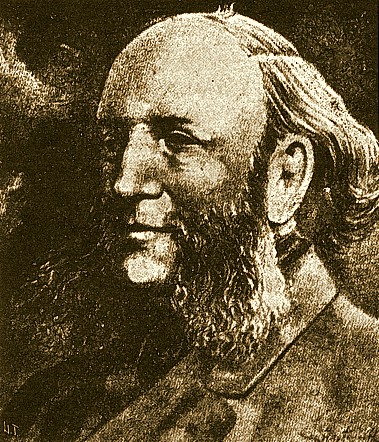
THE WORLD RENOWNED MARINE PAINTER Y O V H A N N
Ē S A I V A Z E
A N
Ayvazovsky's "Noah's Descent from Mt. Ararat" in of itself embodies the holy symbol of Armenia - the Twin Peaks of Masis [Symbolic of the Land of Ararat] . The European art, particularly painting had a strong influence on famous Armenian painters such as Gēorg [Gevork] Bašinjałean [1857-1925], Vardkēs Surēneanc‛, Ełišē Tatevosyan, Step'an Ałajanean, T'anos T'erlemezean and many other notable artists. Gēorg Bašinjałean in particular was a illustrious landscape painter. His almost photo-like, realistic paintings are in deed very beautiful and impressive.
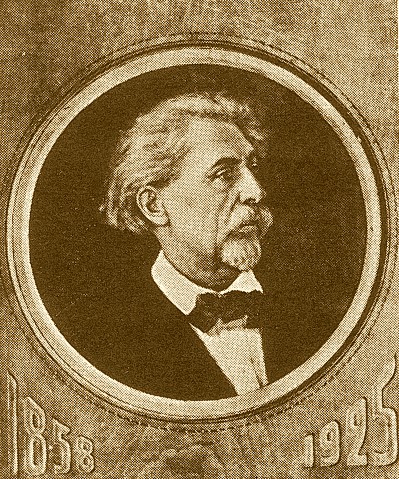
G Ē
O R G
B A Š
I N J
A Ł E
A N

PHOTO OF ARSHILE GORKY [VOSTANIK ADOYEAN]
WITH HIS MOTHER
PICTURE TAKEN PRIOR TO THE HORROR OF THE GENOCIDE. VOSTANIK SURVIVED
THANKS TO THE HUMANITARIAN EFFORTS OF THE RED CROSS AND AMERICAN
MISSIONARIES...BUT HIS BELOVED MOTHER...LIKE HUNDREDS OF THOUSANDS OF
ARMENIANS FELL VICTIM TO THE UNPRECEDENTED BARBARISM OF TURKISH
GOVERNMENT IMPLEMENTED FIRST GENOCIDE OF MODERN ERA...

CHARCOAL SKETCH OF ARTIST'S MOTHER MADE BY GORKY FROM
THE ORIGINAL PHOTOGRAPH IN 1926...
...ARSHILE GORKY [CHANGED HIS NAME IN ADMIRATION OF
THE GREAT RUSSIAN WRITER OF XXTH CENTURY] WENT ON TO BE
A WORLD RENOWNED PAINTER, PRIMARILY WORKING IN THE UNITED STATES.
HE LAUNCHED A NEW ARTISTIC TREND AND GENRE
IN MODERN PAINTING. THE ABOVE PHOTOGRAPH WAS ACTUALLY IMMORTALIZED
IN ONE OF GORKY'S PAINTINGS [THAT ALSO SERVED AS A WHOLE BACKDROP FOR
ATOM EGOYAN'S ARARAT -- A MOVIE ABOUT A MOVIE --DWELT ON THE LIFE OF
GENOCIDE SURVIVOR GORKY. ARSHILE WAS NEVER ABLE TO COMPLETELY
ADJUST TO THE PSYCHOLOGICAL TRAUMA OF THE GENOCIDE AND THE LOSS OF
HIS MOTHER...A SCENE THAT HAUNTED HIM THROUGHOUT HIS LIFE...
EVENTUALLY CULMINATING WITH HIS SUICIDE...

THE VIRGIN ENTHRONED. VARDKĒS SURĒNEANC‛.
1900.
Gēorg Bašinjałean loved to paint mostly the sacred Mt. Ararat and Lake Sevan, which represented the true nature and spirit of the Armenian nation. Vardkēs Surēneanc‛ [1860-1921] is considered the father of Historical Painting, with impressive and artistic paintings of deep historical meaning and value such as, "Ara the Fair", the "Sacrilege of the Holy", "Monastery of St. Hripsimē" and the "Mass" are the finest among the paintings of the second part of the XIXth century.
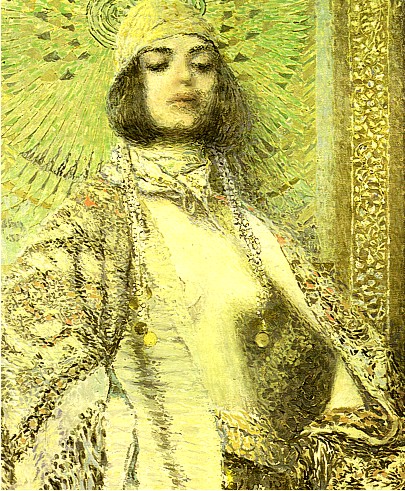
SALOME. VARDKES SURENEANC‛.
1907.
Ełišē Tadēosean [1870-1936] played an important role in the style setting and influence of the development of the Armenian painting motif of not only the XIXth, but as well as the XXth centuries.

THE PAINTING OF A R S H A K C H O B A N I A N. THE GREAT XIXTH CENTURY
POET.

CATHOLICOS K H R I M E A
N H A Y R I K BY VARDKES
SURENEANC‛. 1906.
Step'an Ałajanean [1863-1940] and T'anos T'erlemezean [1865-1941], began painting in the last century, but particularly played an important part in the style setting in 1920's, after the establishment of the "Art Institute of Soviet Armenia" where many new painters accomplished and learnt the art of different styles, manners and techniques that were learned and applied from a total accumulation of the national and as well as international school.
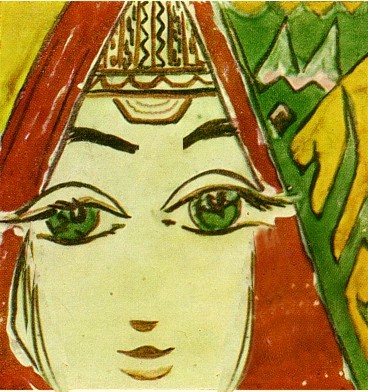
ARMENIAN GIRL OF SYUNIK [ZANGEZUR]. HRIPSIMĒ
SIMONEAN. 1967.
The most eminent figure in Armenian contemporary painting of the XXth century was Martiros Sarian [1880-1972]. Unlike many other artists of the period, whose work was largely effected by the XIXth century Russian and as well as other European painting, Martiros Sarian's art developed in the midst of the stormy and eventful life of the first two decades of our century. Sarian had much more in common with French Post-Impressionist painters, such as Gauguin and Matisse.
GRAPHIC POSTER: N E W A R M E N I A
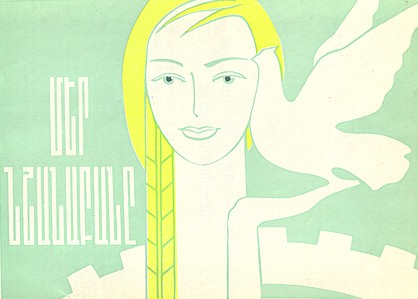
A R M E N
I C F O
L K C O
M M U N I T
Y
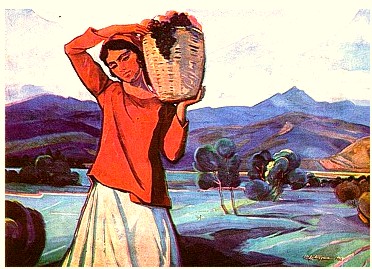
A R M E N I A N G I R L -- T H E P R I D E O F
A R M E N I A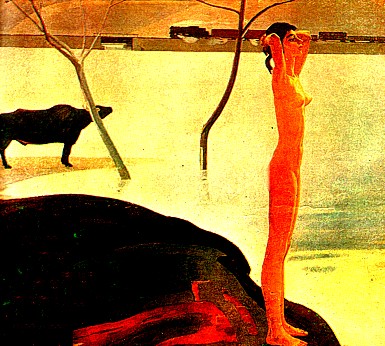
D A
W N. S
A R G I
S M U
R A D E
A N.
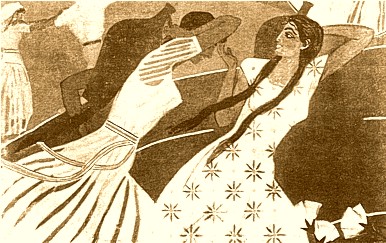
THE D I V I N E S P A R K OF LIFE BURNS BRIGHT WITHIN
THE SUNNY PASSIONATE ARMENIAN SPIRIT
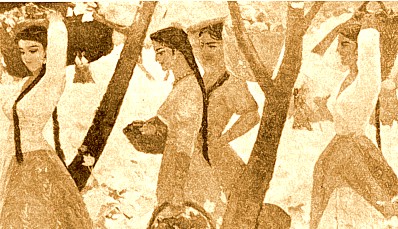
G O L D E N A
U T U M N. L E V O N
M A N A S E R E A N. 1 9 6
2
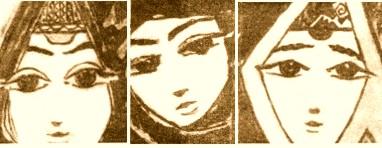
ARMENIAN EYES...BIG AND BRIGHT... LIKE THE NATIONAL
SOUL-SPIRIT IN ITS TRUE ESSENCE
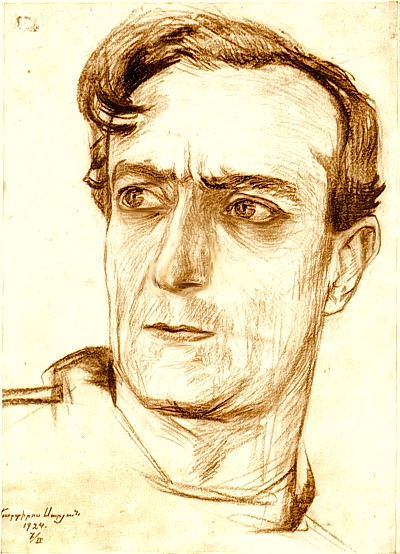
PORTRAIT OF PEOPLE'S ARTIST OF THE USSR -- VAHRAM PAPAZIAN.
BY MARTIROS SARIAN [1924]. WITH STOIC NOBLE ARMENIAN EYES
FULL OF BOUNDLESS DEEPNESS AND ASTUTE MEANING.
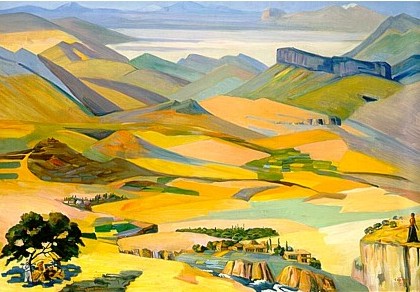
IN THE ARMENIAN HIGHLANDS... [BY MARTIROS SARIAN. 1959.
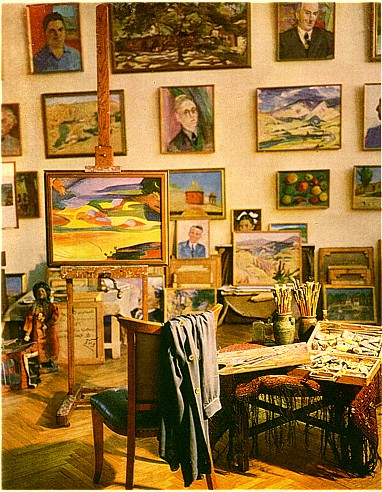
IN THE MASTER'S [M. SARIAN'S] WORK ROOM. NOW AN OPEN MUSEUM.
THE STUDIO WAS TURNED INTO A VIRTUAL SHRINE EVEN DURING THE
PHYSICAL LIFE OF THE GREAT MAN WHO WORSHIPPED THE LIGHT OF
SUNNY COLORS.
Young Russian artists, with whom he studied at the Moscow School of Painting, Sculpture and Architecture, shared his quest for new art. They formed a group called the "Blue Rose" for the purpose of having a united society and exhibitions by all of the artists involved. In the 1910's, Sarian's preferred medium was tempera, and he gave life to this medium in his own inimitable way. His love and object of painting was the Armenian landscape and still life. From there upon the direction of Armenian painters of the XXth century has been strongly influenced by Sarian's work which changed considerably in 1920's.

AUTUMN IN YEREVAN. S. A. ARAKELIAN. 1926.
He also set a new trend in portrait painting by using and incorporating other objects with the backgrounds of the portraits. For instance when painting talented structural and architectural engineer Alexander T'amanean [in 1932] Sarian in the background painted the model structure of the lay out project of the Opera House. The famous of T'amanean shows him to be in thoughts and shows the sensitive lines of concern and burden of the successfulness of the project, showing a slight glance of T'amanean on the archetype model.

ALHAMBRA, SPAIN. VARDKES SURENEANC‛.
1897.
During more then seven decades of his accomplishment and attainment Sarian painted many famous portraits (among whom talented and renowned poet Avetik' Isahakian-1940, Academician I. Orbeli- 1943, famous Soviet poet M. Lozinski-1944, His Holiness Catholicos Vazgen I-1959, I. Erenburg-1959 and many others) of figures from various fields of lifeč and professions. Artists such as S. Arִakelean, M. Abełean, M. Aslamazean and others successfully adopted many of Sarian's qualities in his paintings such as optimism, joyfulness, ability to combine detail with the general outlook.

C E L E B R A T I N G L I F E,
L I G H T A N D
L O V E
THE YEAR'S SEASONS -- AWAKENING -- FERTILITY -- HARVEST
TRIPTYCH BY H. MINASYAN, 1960, THE NATIONAL GALLERY

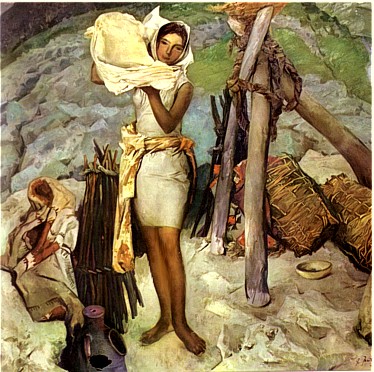
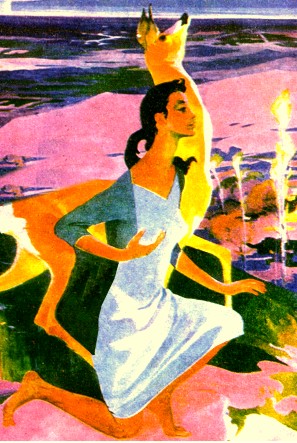
U R G E. Y O V H
A N N Ē S
Z A R D A R E A N. 1960.

M O T H E R A R M E N I A -- CONNECTION TO E R K I R -- THE LAND --
ARMENIANS HAVE A DEEP SENSE OF LOVE FOR THE TOIL OF THE SOIL
THEY HAVE TRADITIONALLY BEEN GIFTED CULTIVATORS --
BUILDERS -- INNOVATORS -- AND CREATORS.
FROM SIMPLE YET IMPORTANT WHEAT HARVEST -- TO THE ERECTION
OF UNSURPASSED WONDER TEMPLES AND
CATHEDRALS LIKE THAT OF MUSASIR AND ZVARTNOTS...
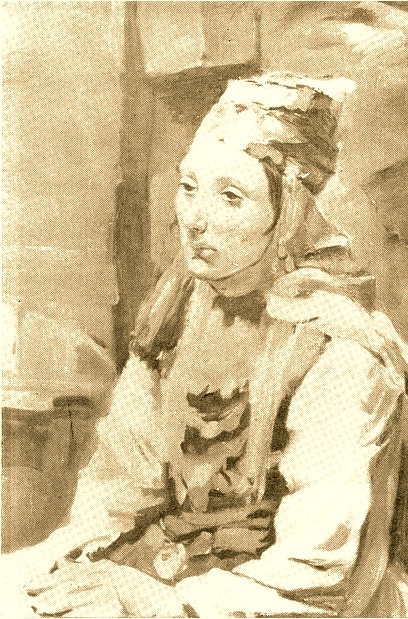
PORTRAIT OF ZEVZEGEAN A YOUNG WOMAN FROM SYUNIK [SIWNIK‛]
WHO WAS
AWARDED THE HONORABLE AWARD OF THE HERO OF SOCIALIST WORK.
HARUT‛IWN GALENC‛ [1956]. A LOT OF SYUNIK WOMEN HAVE GREEN EYES
REFERRED BY THE LOCALS AS 'CAT'S EYES.'
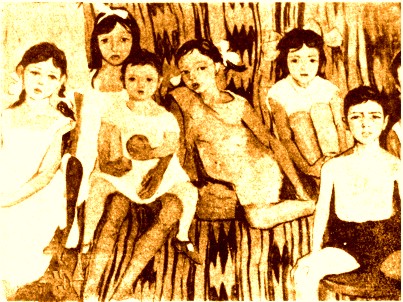
I N F R O N T
O F T H E T V. B Y
V. K A R A P E T E A
N. 1963.

STUDENT FROM SORBONNE O. M. ZARDAREAN. 1958.

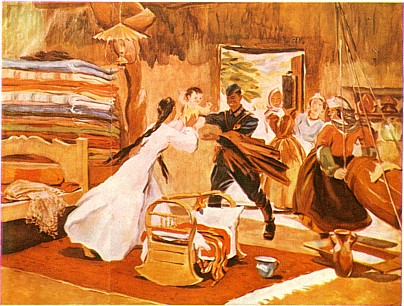
R E T U R N O F T H E H E R O. M. A. A S L A M A Z E A N.
1 9 4 2.
During the Great Patriotic War [1941-1945] the art came ever closer to life. There was a great immediacy in the reaction news from the fronts, and war correspondents' reports. Political posters and cartoons became the order of the day, and painters and sculptors turned to war themes. New names of talented painters appeared on the horizon, painters such as H. Zardarean, E. Isabekean, and X. Esaean and others.
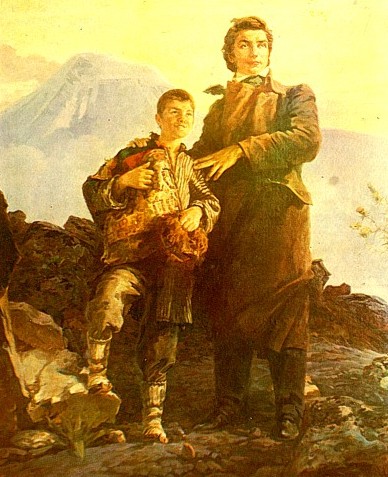
K H A C H A T U R A B O V I A N. THE GREAT
XIXTH CENTURY
ENLIGHTENMENT TEACHER. N E W
D A W N.
THE C O S M I C M O U N T A I N IN THE
BACKGROUND
YOVHANNĒS ZARDARIAN.
1949.
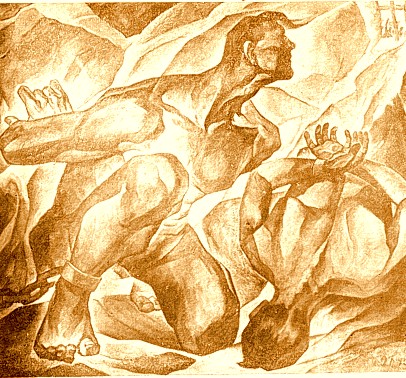
LIBERATION. SUREN PIPOYAN.
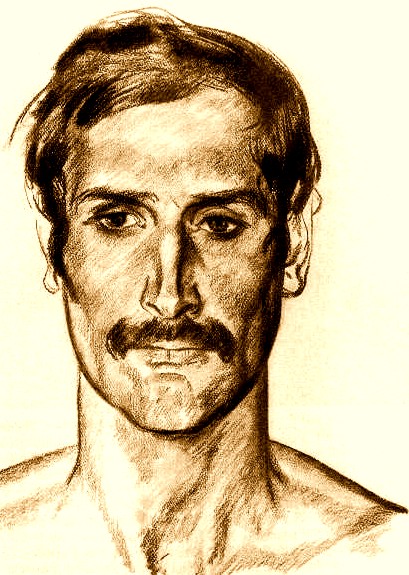
SKETCH OF ONE OF THE ARMENIAN WARRIORS
OF THE HUGE BATTLE OF AVARAYR [VARDANANK‛]
MAGNUM OPUS
PART OF A TRIPTYCH BY GRIGOR KHANJIAN. 1976.
The post war years saw even greater rise of new artists and new talent. In 1946 the Art and Theater-Décor Institute opened, which set in motion a new school and style of skilful artists. By the end of 1950's Armenian artists "discovered" two interesting Armenian painters living in Tp'łis [Tiflis, Tbilisi]: Alexander Bažbeuk-Melik'ean and Gēorg Grigorean [Giotto], their work was contemplated and adopted by many of the artists of late 1950's and 1960's.

ALEXANDER SPENDAREAN. THE GREAT COMPOSER WHO AMONG OTHER
WORKS
WROTE THE HIGHLY INSPIRING ALMAST OPERA. BY MARTIROS SARIAN.
M I L L E N N I A O L D A R M E N I A N T R A D I T I O N S
REVOLVE AROUND TIGHTLY KNIT WARM FAMILY LIFE

BREAD AND DREAMS. GRIGOR KHANJIAN.
1964.
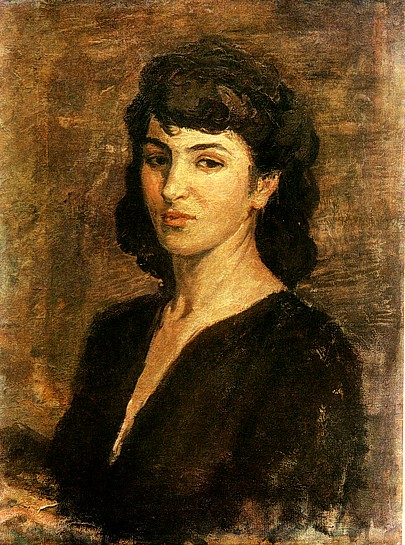
A. A. NALBANDEAN. SELF-PORTRAIT. 1946.
Famous Armenian painters of Paris such as Georges Yakulov and Ervand Koar also had a great impact upon the development of modern painting of the 1960's. Ervand Kočar famed for the beautiful and impressive sculpture of Sasunc‛i Davit' [David of Sassoun] was also a gifted painter who had a unique style of his own, which also developed a strong following.
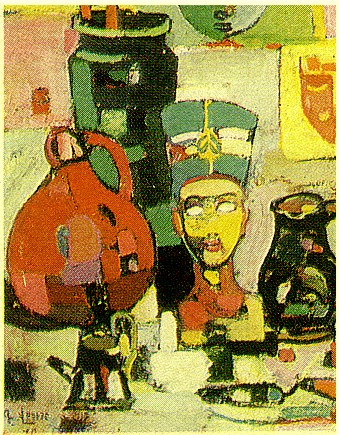
VRUYR GALSTEAN. STILL LIFE WITH MASKS. 1970.
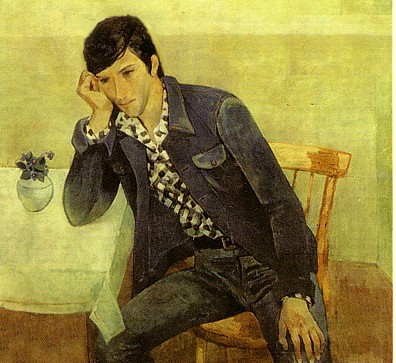
YOUNG MAN THINKING. BY THE RENOWNED
PEOPLE'S ARTIST OF RA Y. YAKOBEAN. CA. 1972.
Among the world famous Armenian painters of this period were H. Galentz, A.Galenc‛, P. Konturajean, and A. Łaribean. Harut'iwnn Galenc‛ was the most interesting of them for he was a truly lyrical artist and a master of color.
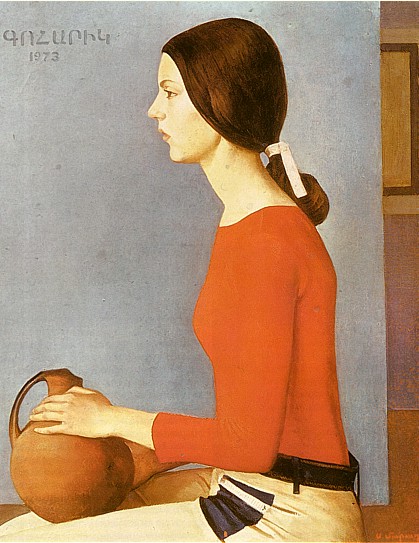
GOHARIK WITH A PITCHER. S. MURADEAN. 1973.
The fine artistry of his work left a deep imprint on Armenian taste and increased the public's and the artist's knowledge and understanding of modern Western European art. The picture of present-day Armenian art would be incomplete without a glance at the culture of the Armenian Diaspora. Nowadays, a great number of Armenian artists live and work all round the world, and, although their work now essentially belongs to their adopted countries, it still has strong links with Armenia, its history and tradition.
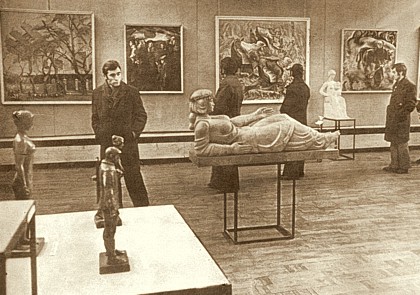
T H E A N N U A L A R T E X H I B I T I O N I N T H E N A T I O N A L G A L L E R Y
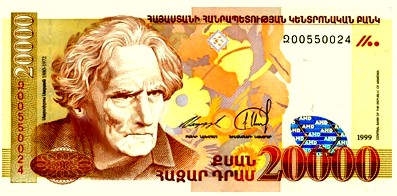
THE OBVERSE OF THE 20,000 DRAM NOTE ISSUED IN 1999 BY THE CENTRAL BANK OF
ARMENIA COMMEMORATING AND HONORING THE LIFE AND WORK OF SARIAN.
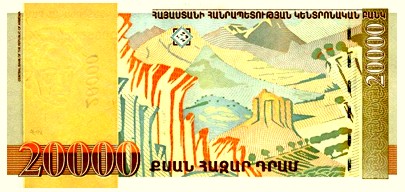
REVERSE OF THE BANK NOTE DEPICTING OF ONE OF SARIAN'S
COUNTLESS WORKS DEPICTING THE BREATHTAKING ALPINE VISTAS --
THE HIGH MOUNTAINS AND LUSH VALLEYS OF THE PROUD ARMENIAN LANDSCAPE.
Among the most remarkable names to be mentioned here are those of the painter -- nom de plum -- Arshile Gorky [Vostanik Adoyan] who made an important contribution to contemporary American painting and of the well-known French painter and graphic artist Carzou [Garnik Zulumean]. Regular exhibitions in Armenian of Armenian artists from abroad, their frequent visits and, above all, their paintings of modern Armenian life link them to Armenia's cultural life. One of the great historical painters of our time [continuing the school set forth by Vardkēs Surēneanc‛] is Grigor Xanjean, one of his greatest works is the great triptych of the Cascade-Monument [the halls and steps leading to the obelisk] in Yerevan -- The Battle of Avarayr, The Armenian Alphabet and Armenia Reborn which
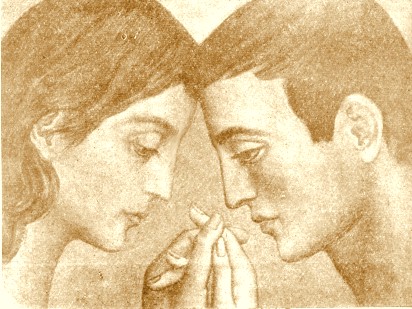
Y O U
T H. R.
K H A C H A
T R E A N. 1966.
in of itself compromise the millennia of Armenian painting tradition. Beginning from the seals and symbols of Aratta and the cave paintings of the prehistoric times, the frescos of Mitanni and Kingdom of Ararat, to our own times, the Armenian legacy has accumulated -- in and of itself represents not only the art and culture, but as well as the history and the true noble Essence of the Armenian nation.